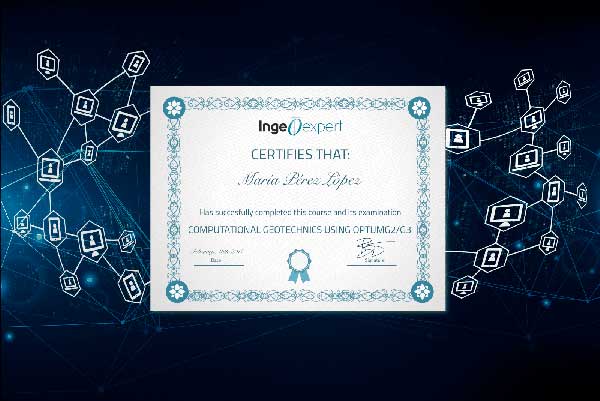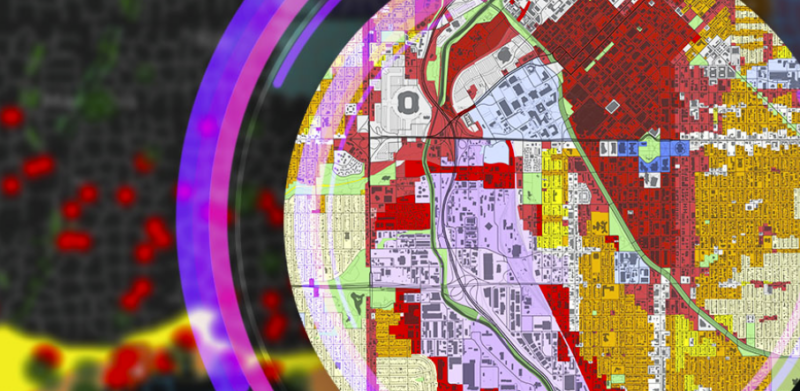Introduction to Geographic Information Systems and ArcGIS
Online course |
|
50 hours / 6 weeks |
|
To be determined |
Introduction
In this course, you will learn the core of ArcGIS platform through lessons, demos and step by step exercises, starting from designing and creating maps, carry out spatial analysis, built and edit spatial databases, creating Web GIS Services and developing web applications.
We will go through the fundamentals of GIS technology and geographic data. In this course, you will gain experience using GIS maps to visualize and explore real-world features; analyze data to answer questions and create new information; and share maps, data, and other resources so they can be easily accessed throughout the organization you are working for.
The exercises, and mini projects will be supported by discussions to enhance technical understanding.
The course will consist of Lectures, open discussion, lecture exercises, and description of the project assignment relative to the weekly topic. The instructor will be available to assist students with exercises, assignments, and projects during lab and/or office hours
Objectives
- Give an Overall of GIS, Discuss Geographic Information Systems (GIS) concepts
- Presenting ArcGIS platform Desktop, Enterprise, ArcGIS Online
- Become familiar with the ArcGIS interface and operation
- Be able to use ArcGIS Pro, ArcMap, ArcCatalog, and GIS Tools
- Interacting with Maps and data
- Displaying and presenting data
- Creating and editing data
- Learn how to use GIS for analysis
- Effectively present data in map layouts
- Provide opportunities to ask questions and participate
Limited places.
Week 1
- Lesson introduction
- GIS components
- GIS capabilities
- Exploring GIS capabilities
- The geographic approach
- What is ArcGIS?
- Explore a story using ArcGIS
- The ArcGIS Pro user interface
- Exercise: Use ArcGIS
- – Open an ArcGIS Pro project
- – Navigate a map
- – Sign in to ArcGIS Online
- – Search for a web map
- – Navigate a web map
- Lesson review and Quiz (with answers)
Week 2
- Presenting ArcGIS platform Desktop, Enterprise, ArcGIS Online
- Interacting with Maps and GIS data
- Displaying and presenting GIS data
- Creating GIS data (creating file geodatabase, feature datasets, subtypes, domains, relationships).
- Editing GIS data
- Geoprocessing
- Exercise: Interacting with Maps, and online resources
Week 3
- Lesson introduction
- Spatial data Working with tables Vector data
- Raster data and imagery
- Representing real-world objects
- Managing GIS data
- Exploring coordinate systems
- Choosing GIS data
- Data collection methods
- Searching for geographic data in ArcGIS platform.
- Exercise: Exploring data collection
Week 4
- Lesson introduction
- Data management with geodatabases
- Adding data to a map
- Metadata
- – Practice: Explore data management
- – Open an ArcGIS Pro project View the properties of a layer
- – Use the Catalog pane to organize data
- – Review metadata
- Create a group layer to organize the Contents pane
- Web layers
- Using web layers
- Sharing data in ArcGIS
- Exercise: Share data in ArcGIS
- – Share data as a web layer View a web layer in ArcGIS Online
- – Lesson review and Quiz
Week 5
- Lesson introduction
- Representing data on maps
- Different Coordinate systems
- The importance of coordinate systems
- Map projections and distortion
- Explore spatial distortion
- – Exercise: Working with coordinate systems
- – Prepare your ArcGIS project
- – Examine the coordinate system of a map
- Mapping and visualization
- Spatial analysis
- Examine the coordinate system of a layer
- Compare a map with a different coordinate system
- – Lesson review and Quiz
Week 6
- Lesson introduction
- What is spatial analysis
- Spatial analysis workflow Types of spatial analysis
- Identifying types of analysis
- – Exercise: Use ArcGIS to explore 3D analysis
- Prepare a web scene
- Analyze building height
- Analyze daylight
- Performing analysis in ArcGIS Pro
- – Exercise: Use ArcGIS Pro for spatial analysis
- Prepare an ArcGIS Pro project
- Use tools to prepare data for analysis
- Run a geoprocessing models
- Review the analysis results Visualize a chart
- Performing analysis in ArcGIS Online
- – Exercise 6C: Use ArcGIS Online for spatial analysis
- Add data to a web map
Abdel-Hadi Hor
I’m a Subject Matter Expert and and results driven senior Enterprise GIS solutions architect, Senior Consultant, and a ArcGIS Certified ArcGIS instructor with extensive experience of over 20 years+ using the design, development, implementation, training of Enterprise geospatial platforms and solutions for major companies in USA and Canada, I helped many organizations to reach their business objectives by leveraging GIS capabilities to different applications for public works, health, transportation, telecommunications, Utilities and governmental departments.
- – LinkedIn : Abdel-Hadi Hor | LinkedIn
- – Twitter : @HadiHor
All of our courses are offered 100% online, through our intuitive Virtual Campus. Topics are taught through:
- – Videos
- – Interactive multimedia content
- – Live classes
- – Texts
- – Case studies
- – Evaluation exercises
- – Additional documentation
The content is updated in each new course edition, so that knowledge is acquired around the latest news and state-of-the-art geotechnical engineering technology.
One of the most interesting aspects of our courses is the use of live videoconferences, in which teachers and students interact in a continuous exchange of knowledge and problem solving. In addition to this, students can make use of the platform’s forum, a meeting point where they can interact with teachers and other students.
A tutoring system will also be established by email, which will resolve any possible doubts about the course, and which will serve as a point of connection for students with specific questions on each module.
Students can also download all course documentation, including texts, videos, video conferences and exercises.
By completing this course, the student will be well qualified to perform GIS tasks and applications in any of the following fields:
- – Engineering: surveying, civil, architecture, Geomatics.
- – Utilities: oil and gas pipelines, electrical transmission, telecommunications
- – Business: marketing, real estate, property development.
- – Education: colleges, universities, research institutes, libraries.
- – Government: urban and regional planning, public administration, health, education, heritage, tourism.
- – Natural resource management/environmental management: air, land, and water including forestry, agriculture, fisheries, mining.
- – Research: physical and biological, social sciences, humanities.
- – Security: public safety, law enforcement, immigration, national security, defense.
- – Transportation: planning, systems management.
At the end of the course, and as accreditation of knowledge acquired and of the technical and practical training, students who correctly complete the corresponding evaluation tests of the geotechnical engineering course will obtain an academic certificate issued by Ingeoexpert. This digital certificate is protected by Blockchain technology, making it unique and tamper-proof, thus enabling companies to verify its authenticity.
It can also be downloaded by students, forwarded by email and shared on social networks, as well as embedded on any website. You can see an example here.
- – GIS Technician
- – GIS Specialist
- – GIS Data Analyst
- – GIS project Manager
- – GIS Business Analyst
- – GIS Solution Architect
- – GIS Integration Specialist
Introduction
In this course, you will learn the core of ArcGIS platform through lessons, demos and step by step exercises, starting from designing and creating maps, carry out spatial analysis, built and edit spatial databases, creating Web GIS Services and developing web applications.
We will go through the fundamentals of GIS technology and geographic data. In this course, you will gain experience using GIS maps to visualize and explore real-world features; analyze data to answer questions and create new information; and share maps, data, and other resources so they can be easily accessed throughout the organization you are working for.
The exercises, and mini projects will be supported by discussions to enhance technical understanding.
The course will consist of Lectures, open discussion, lecture exercises, and description of the project assignment relative to the weekly topic. The instructor will be available to assist students with exercises, assignments, and projects during lab and/or office hours
Objectives
- Give an Overall of GIS, Discuss Geographic Information Systems (GIS) concepts
- Presenting ArcGIS platform Desktop, Enterprise, ArcGIS Online
- Become familiar with the ArcGIS interface and operation
- Be able to use ArcGIS Pro, ArcMap, ArcCatalog, and GIS Tools
- Interacting with Maps and data
- Displaying and presenting data
- Creating and editing data
- Learn how to use GIS for analysis
- Effectively present data in map layouts
- Provide opportunities to ask questions and participate
Limited places.
Week 1
- Lesson introduction
- GIS components
- GIS capabilities
- Exploring GIS capabilities
- The geographic approach
- What is ArcGIS?
- Explore a story using ArcGIS
- The ArcGIS Pro user interface
- Exercise: Use ArcGIS
- – Open an ArcGIS Pro project
- – Navigate a map
- – Sign in to ArcGIS Online
- – Search for a web map
- – Navigate a web map
- Lesson review and Quiz (with answers)
Week 2
- Presenting ArcGIS platform Desktop, Enterprise, ArcGIS Online
- Interacting with Maps and GIS data
- Displaying and presenting GIS data
- Creating GIS data (creating file geodatabase, feature datasets, subtypes, domains, relationships).
- Editing GIS data
- Geoprocessing
- Exercise: Interacting with Maps, and online resources
Week 3
- Lesson introduction
- Spatial data Working with tables Vector data
- Raster data and imagery
- Representing real-world objects
- Managing GIS data
- Exploring coordinate systems
- Choosing GIS data
- Data collection methods
- Searching for geographic data in ArcGIS platform.
- Exercise: Exploring data collection
Week 4
- Lesson introduction
- Data management with geodatabases
- Adding data to a map
- Metadata
- – Practice: Explore data management
- – Open an ArcGIS Pro project View the properties of a layer
- – Use the Catalog pane to organize data
- – Review metadata
- Create a group layer to organize the Contents pane
- Web layers
- Using web layers
- Sharing data in ArcGIS
- Exercise: Share data in ArcGIS
- – Share data as a web layer View a web layer in ArcGIS Online
- – Lesson review and Quiz
Week 5
- Lesson introduction
- Representing data on maps
- Different Coordinate systems
- The importance of coordinate systems
- Map projections and distortion
- Explore spatial distortion
- – Exercise: Working with coordinate systems
- – Prepare your ArcGIS project
- – Examine the coordinate system of a map
- Mapping and visualization
- Spatial analysis
- Examine the coordinate system of a layer
- Compare a map with a different coordinate system
- – Lesson review and Quiz
Week 6
- Lesson introduction
- What is spatial analysis
- Spatial analysis workflow Types of spatial analysis
- Identifying types of analysis
- – Exercise: Use ArcGIS to explore 3D analysis
- Prepare a web scene
- Analyze building height
- Analyze daylight
- Performing analysis in ArcGIS Pro
- – Exercise: Use ArcGIS Pro for spatial analysis
- Prepare an ArcGIS Pro project
- Use tools to prepare data for analysis
- Run a geoprocessing models
- Review the analysis results Visualize a chart
- Performing analysis in ArcGIS Online
- – Exercise 6C: Use ArcGIS Online for spatial analysis
- Add data to a web map
Abdel-Hadi Hor
I’m a Subject Matter Expert and and results driven senior Enterprise GIS solutions architect, Senior Consultant, and a ArcGIS Certified ArcGIS instructor with extensive experience of over 20 years+ using the design, development, implementation, training of Enterprise geospatial platforms and solutions for major companies in USA and Canada, I helped many organizations to reach their business objectives by leveraging GIS capabilities to different applications for public works, health, transportation, telecommunications, Utilities and governmental departments.
- – LinkedIn : Abdel-Hadi Hor | LinkedIn
- – Twitter : @HadiHor
All of our courses are offered 100% online, through our intuitive Virtual Campus. Topics are taught through:
- – Videos
- – Interactive multimedia content
- – Live classes
- – Texts
- – Case studies
- – Evaluation exercises
- – Additional documentation
The content is updated in each new course edition, so that knowledge is acquired around the latest news and state-of-the-art geotechnical engineering technology.
One of the most interesting aspects of our courses is the use of live videoconferences, in which teachers and students interact in a continuous exchange of knowledge and problem solving. In addition to this, students can make use of the platform’s forum, a meeting point where they can interact with teachers and other students.
A tutoring system will also be established by email, which will resolve any possible doubts about the course, and which will serve as a point of connection for students with specific questions on each module.
Students can also download all course documentation, including texts, videos, video conferences and exercises.
By completing this course, the student will be well qualified to perform GIS tasks and applications in any of the following fields:
- – Engineering: surveying, civil, architecture, Geomatics.
- – Utilities: oil and gas pipelines, electrical transmission, telecommunications
- – Business: marketing, real estate, property development.
- – Education: colleges, universities, research institutes, libraries.
- – Government: urban and regional planning, public administration, health, education, heritage, tourism.
- – Natural resource management/environmental management: air, land, and water including forestry, agriculture, fisheries, mining.
- – Research: physical and biological, social sciences, humanities.
- – Security: public safety, law enforcement, immigration, national security, defense.
- – Transportation: planning, systems management.
At the end of the course, and as accreditation of knowledge acquired and of the technical and practical training, students who correctly complete the corresponding evaluation tests of the geotechnical engineering course will obtain an academic certificate issued by Ingeoexpert. This digital certificate is protected by Blockchain technology, making it unique and tamper-proof, thus enabling companies to verify its authenticity.
It can also be downloaded by students, forwarded by email and shared on social networks, as well as embedded on any website. You can see an example here.
- – GIS Technician
- – GIS Specialist
- – GIS Data Analyst
- – GIS project Manager
- – GIS Business Analyst
- – GIS Solution Architect
- – GIS Integration Specialist
More info
Finish this course and get a certificate based on Blockchain
Introduction to Geographic Information Systems and ArcGIS

Blockchain technology makes the certificate incorruptible, enabling companies to verifiy its autenticity.





Reviews
There are no reviews yet.